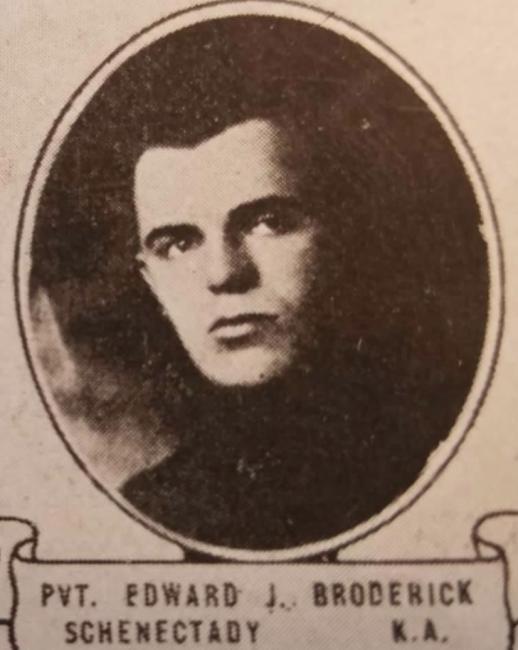
About
Edward James Broderick, the son of Thomas and Susan (Finster) Broderick, was born on April 8, 1891, in Rome, New York. By the 1892 census, he was residing in Schenectady. He worked for General Electric and was a committed Mont Pleasant Athletic Club participant. Additionally, Edward played baseball on a semi-pro level.
On July 25, 1917, Edward enlisted in the United States Army. He held the rank of Private and served with the Machine Gun Company, 105th Infantry Regiment, 27th Infantry Division. Edward had gone to confession and received Holy Communion from Rev. Father Francis E. Kelley, a well known Albany priest who served as the 27th Infantry Division's chaplain in France, on August 11, 1918. Edward was shot in the chest and died a few hours after his meeting with Father Kelley. Edward is buried in St. John the Baptist Cemetery, Schenectady, New York.
Sources: The Albany Times Union, Find A Grave, Ancestry
Edward Broderick and the "Fighting Chaplain"
American Chaplains were needed during World War I to provide pastoral and personal counseling, ministry to the wounded and dying, and supervision over the burial of soldiers. They were also needed to bring comfort and support to the frightened men who might not live to see another day. Father Francis Kelley from Cohoes, New York, was one of those chaplains who performed all his duties and risked his life for his men. Edward Broderick from Schenectady, New York, was one of the soldiers Father Kelley would comfort and celebrate sacraments with. A chaplain and a soldier from the Albany Diocese coming together on a battlefield in Belgium.
Edward (Eddie) James Broderick, the only son of Thomas and Susan Broderick, was born on April 8, 1891 in Rome, New York. By the 1892 census, he was living in Schenectady, New York, where he attended local schools and was employed by the General Electric Company. Edward was an active member of the Mont Pleasant Athletic Club, and he was also a semi professional baseball player. Edward enlisted in the United States Army on July 25, 1917. He had a rank of Private and served with the Machine Gun Company, 105th Infantry Regiment, 27th Infantry Division. He was sent overseas aboard the US Grant on May 17, 1918.
Father Francis Alphonsus Kelley, the son of John and Mary Kelley, was born on April 19, 1888 in Cohoes, New York. He attended St. Bernard’s Academy and graduated in 1904. He also studied at Niagara University and was ordained a priest in 1914 by Bishop Thomas M.A. Burke in Albany, New York. Father Kelley enlisted in the United States National Guard on July 16, 1917. By December 18, 1917 he was serving in the United States Army with the 104th Machine Gun Battalion, 27th Infantry Division. He had a rank of First Lieutenant Chaplain and was sent overseas aboard the US Grant on May 17, 1918.
In August 1918, Edward and Father Kelley were both deployed at Mont Kemmel, Belgium for the Battle of Vierstraat Ridge. The 27th Infantry Division had entered the battle in the beginning of August. On August 11, 1918, Edward went to Father Kelley for confession and received Holy Communion. Ten hours later Edward was mounting his machine gun when enemy fire passed through his heart. The entire company mourned the loss of such a loyal soldier and friend. Edward was buried overseas with full military honors and was then brought back to Schenectady, New York, years later to be laid to rest at St. John the Baptist Cemetery in Schenectady.
In a letter to his mother, published in the Albany Evening Journal, he wrote:
“You don’t want to feel bad because I am going to France. You want to cheer up and be happy as ever as I will be only one of the 5,000,000 men that will be over there, so you don’t want to have in mind that I am the only one to go across. Be proud of your son, a member of the club. Think of how many other mothers have sons in the Army.”
Father Kelley suffered a personal loss during the war–his younger brother George Anthony, who served with the 104th Machine Gun Battalion, 27th Infantry Division, died on November 5, 1918 of pneumonia. Both brothers were sent overseas on the same day. Father Kelley served overseas from May 17, 1918 until February 19, 1919, and was discharged on March 31, 1919. After completing his post war work, he was assigned to St. Mary’s in Troy, New York. Later he was assigned to Glen Falls, New York, Gloversville, New York, and then Cairo, New York, where he died on October 15, 1931. Father Kelley suffered many health problems because of the gas he inhaled in France during the war while rescuing and administering to the wounded. Father Kelley was laid to rest at St. Mary’s Cemetery, Troy, New York in the same plot as his brother George Anthony.
Sources: The Schenectady Gazette, Find A Grave, Ancestry, Albany’s Part in the World War, 1919, Albany Evening journal, Times Union
